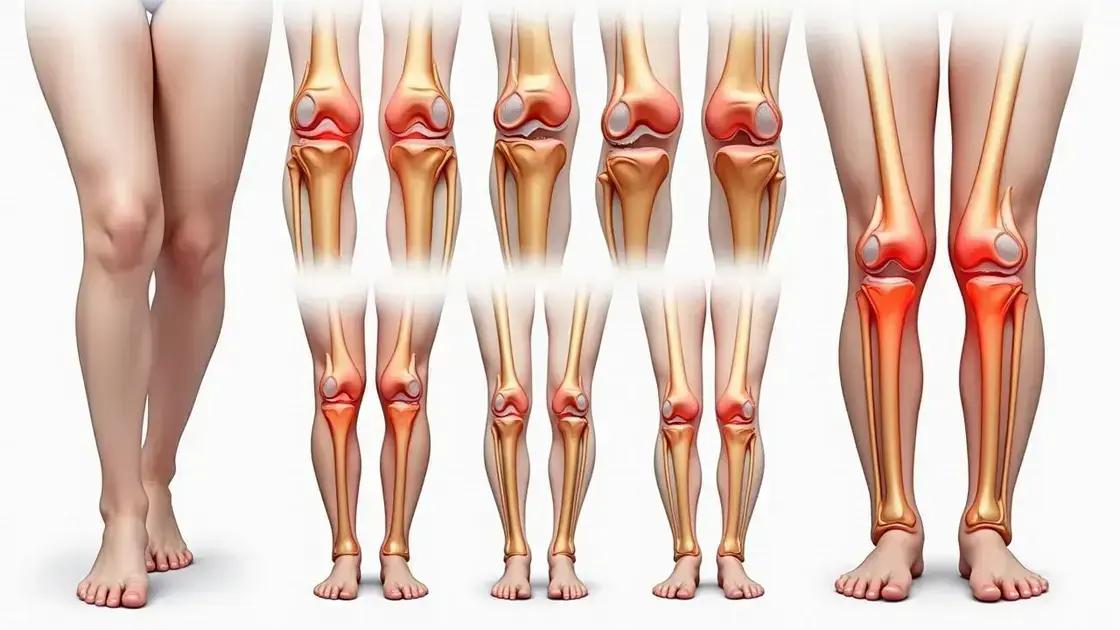To strengthen weak knees with exercise, focus on targeted movements like straight leg raises, wall sits, and step-ups, while protecting your knees through proper warm-up, footwear, and form. Seek professional help if experiencing persistent pain, swelling, or instability.
Weak knees can hinder your mobility and affect your overall quality of life. Learning how to strengthen weak knees with exercise is essential for enhancing stability and reducing pain. In this article, we will explore effective exercises, precautions to take while exercising, and tips to keep your knees healthy. Whether you’re an athlete or someone dealing with knee discomfort, these insights will be beneficial.
Understanding Knee Weakness and its Causes

Knee weakness can be a common issue for many people, affecting their mobility and overall health. It may result from various factors, including injuries, age, and lifestyle choices. Understanding these causes is essential for effectively addressing the problem.
Common Causes of Knee Weakness
Injuries such as ligament tears, meniscus damage, or fractures can lead to weakness in the knee joint. When these injuries occur, it can cause pain, swelling, and reduced mobility, making it difficult to perform regular activities.
Aging is another factor that contributes to knee weakness. As we grow older, the cartilage in our knees may wear down, leading to conditions like arthritis, which can result in pain and decreased strength.
Obesity can also play a significant role in knee weakness. Carrying excess weight increases the stress on knee joints, leading to wear and tear, and ultimately causing weakness.
Lifestyle Factors Impacting Knee Health
Lack of exercise can weaken the muscles surrounding the knees. Regular physical activity strengthens these muscles and supports the knee joint. Conversely, a sedentary lifestyle can lead to muscle atrophy and increased susceptibility to injuries.
Improper footwear can negatively impact knee stability. Wearing shoes that do not provide adequate arch support and cushioning can contribute to knee pain and weakness over time. It’s essential to invest in proper footwear for activities to maintain knee health.
Lastly, repetitive strain from certain sports or occupations can lead to knee weakness. Continuous stress can impact the knee’s structure and function, leading to fatigue and increased risk of injury.
Essential Exercises for Strengthening Weak Knees

Strengthening weak knees involves specific exercises that target the muscles around the knee joint. These exercises can improve stability, flexibility, and strength. Here are some essential exercises to incorporate into your routine.
1. Straight Leg Raises
Lie on your back with one leg bent and the other leg straight. Slowly lift the straight leg to the height of the bent knee, then lower it back down. Repeat this 10 to 15 times for each leg. This exercise strengthens the quadriceps, which are vital for knee support.
2. Wall Sits
Stand with your back against a wall. Slide down until your knees are at a 90-degree angle, as if sitting in a chair. Hold this position for 20 to 30 seconds and repeat 3 to 5 times. Wall sits are effective for building endurance in the thighs and stabilizing the knees.
3. Step-Ups
Find a sturdy step or platform. Step up with one foot, bringing the other foot to join it on the step. Step back down and repeat 10 to 15 times on each leg. This exercise helps strengthen the muscles used in daily activities like climbing stairs.
4. Calf Raises
Stand straight with your feet shoulder-width apart. Slowly raise your heels off the ground, balancing on your toes. Hold for a moment, then slowly lower back down. Aim for 10 to 15 repetitions. Calf raises help improve overall leg strength and stability.
These exercises can be performed 2 to 3 times a week. Always remember to warm up before starting your workout, and listen to your body to avoid injury. Consulting with a professional may also be beneficial if you’re unsure about your exercise form.
Tips for Protecting Your Knees During Exercise

Protecting your knees during exercise is vital to prevent injury and ensure long-term health. Here are effective tips to keep your knees safe while staying active.
1. Warm Up Properly
Before any workout, it’s essential to warm up. Spend 5 to 10 minutes doing gentle movements like walking or cycling to get blood flowing to your muscles. This prepares your knees for more intense activity.
2. Use Proper Footwear
Wearing the right shoes can make a big difference. Choose shoes with good arch support and cushioning. This helps absorb impact and reduces strain on your knees while exercising.
3. Focus on Form
Maintaining good form is crucial during exercises. When performing movements like squats or lunges, ensure your knees do not extend past your toes. This minimizes stress on the knees and reduces the risk of injury.
4. Avoid High-Impact Activities
If you have weak knees, avoid high-impact exercises like running on hard surfaces. Instead, opt for low-impact alternatives such as swimming, cycling, or using an elliptical machine. These options put less stress on your joints.
5. Incorporate Strength Training
Strengthening the muscles around your knees can provide additional support. Include exercises that target the quadriceps, hamstrings, and calves regularly in your routine to enhance knee stability.
6. Listen to Your Body
Pay attention to how your knees feel during exercise. If you experience any pain or discomfort, stop the activity immediately. Pushing through pain can worsen your condition.
Incorporating these tips into your exercise routine can help protect your knees while strengthening them for better function.
When to Seek Professional Help for Knee Issues

Knowing when to seek professional help for knee issues is crucial for maintaining healthy joints. If you experience any of the following signs, it is time to consult a healthcare provider.
1. Persistent Pain
If knee pain continues for more than a few days and does not improve with rest, ice, or over-the-counter medications, seek professional advice. Prolonged pain can be a sign of a more serious issue.
2. Swelling
Swelling around the knee joint that does not go down can indicate inflammation or injury. If the knee feels swollen, take note of the duration and severity and consult a doctor.
3. Reduced Range of Motion
If you notice restricted movement in your knee or find it hard to fully extend or bend your leg, it may indicate damage to the structures inside your knee. A healthcare provider can assess the problem.
4. Difficulty Bearing Weight
If you experience pain or discomfort when trying to put weight on your knee, it is a warning sign. This can indicate weakness or injury that needs professional evaluation.
5. Instability
Feeling like your knee might give way or experience instability during activities can be a sign of torn ligaments or cartilage damage. Seek help from a medical professional to assess your knee’s stability.
6. History of Knee Problems
If you have a past history of knee injuries or conditions like arthritis, keeping an eye on any changes in your knee’s condition is essential. Consult your doctor if you notice new symptoms or changes.
Getting an early diagnosis can lead to more effective treatment options and help you return to your activities sooner. Don’t hesitate to seek help for your knee concerns.
In conclusion, strengthening weak knees through exercise is essential for maintaining mobility and reducing pain.
By understanding the causes of knee weakness and incorporating targeted exercises, you can significantly improve knee stability and strength.
Additionally, it’s important to protect your knees during physical activity by following proper techniques and knowing when to seek professional help.
Implementing these effective tips will not only enhance your knee health but also enable you to enjoy a more active lifestyle with confidence.
FAQ – Frequently Asked Questions about Strengthening Weak Knees
What are the best exercises for strengthening weak knees?
Essential exercises include straight leg raises, wall sits, step-ups, and calf raises, which target the muscles around the knee.
How can I protect my knees during workouts?
To protect your knees, warm up properly, wear good footwear, maintain proper form, and avoid high-impact activities.
When should I seek professional help for knee problems?
Seek help if you experience persistent pain, swelling, difficulty bearing weight, instability, or reduced range of motion.
Can I strengthen my knees at home?
Yes, many knee-strengthening exercises can be done at home with minimal equipment, such as resistance bands or weights.
Is there a specific diet that can help improve knee strength?
A balanced diet rich in anti-inflammatory foods, such as fruits, vegetables, healthy fats, and lean proteins can support joint health.
How often should I exercise my knees for best results?
Aim to incorporate knee-strengthening exercises into your routine 2 to 3 times a week, allowing for rest and recovery.












